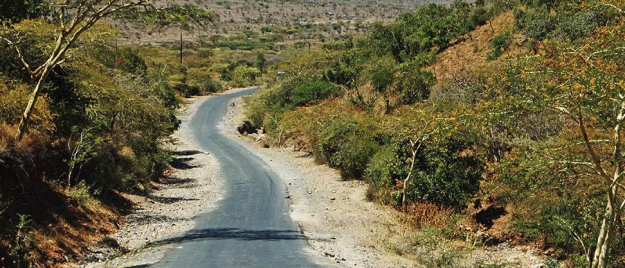 We return to Nakuru to pick up again on what is now the main line. In 1929 the Uganda Railway became Kenya and Uganda Railways and Harbours (KURH), which in 1931 completed a branch line to Mount Kenya and extended the main line from Nakuru to Kampala in Uganda.
We return to Nakuru to pick up again on what is now the main line. In 1929 the Uganda Railway became Kenya and Uganda Railways and Harbours (KURH), which in 1931 completed a branch line to Mount Kenya and extended the main line from Nakuru to Kampala in Uganda.
In 1948 KURH became part of the East African Railways Corporation, which added the line from Kampala to Kasese in western Uganda in 1956.[1] and extended to it to Arua near the border with Zaïre in 1964.[2] We start the next part of the journey at Nakuru Station. The map above shows the length of the line to the junction with the line to Kisumu. The MPD can be picked out adjacent to the triangle for turning locos. The passenger station is t the right of the map extract. The Goods Yard is the are to the right of the triangle.
We start the next part of the journey at Nakuru Station. The map above shows the length of the line to the junction with the line to Kisumu. The MPD can be picked out adjacent to the triangle for turning locos. The passenger station is t the right of the map extract. The Goods Yard is the are to the right of the triangle.
There is good coverage of the station on the earlier post about the line from Nakuru to Kisumu …..
https://wordpress.com/post/rogerfarnworth.com/8058
The images immediately below show the Passenger Railway Station at Nakuru in the 21st century – they are sourced as follows – the first from Google Maps and the following three from Google Streetview. ….

Nakuru Passenger Station – to the Northwest of the station, the line passed immediately over the Nakuru ring-road before swinging round to the West, (Google Maps).

View from the Road to the East of the Station, (Google Streetview).

View from the Town Centre roads to the South of the Station, (Google Streetview).
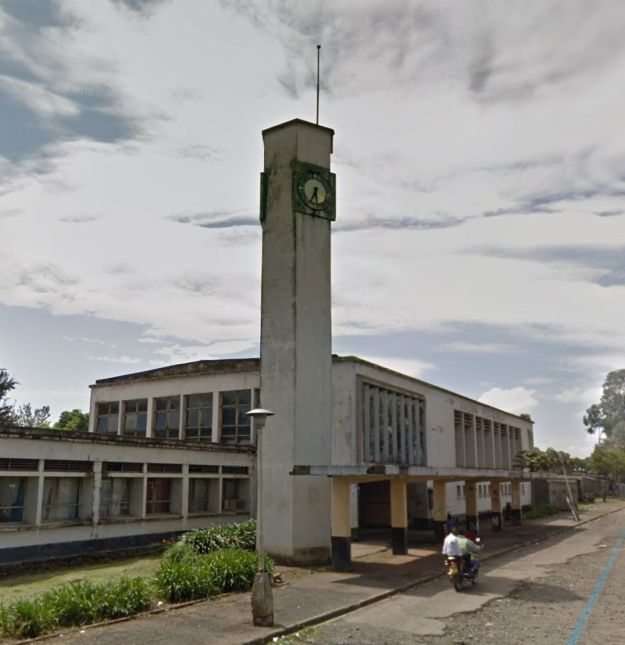
View of the main Station Building from the West, (Google Streetview).
There are a number of sites on the web which have pictures of locomotives at Nakuru Railway Station. These include: …
- Christopher Yapp took a photograph of Class 30 No. 3020 ‘Nyaturu’ 2-8-4 on a charter in 2005. [5]
- An earlier photograph of a Class 60 Garratt (still bearing its Governor’s name plate and without Giesl ejector) waiting to take the Uganda Mail forward from Nakuru was taken by Geoff Pollard. [6]
- By 1962, Class 58 Garratt locomotives had replaced the Class 60s between Nakuru and Kampala.
And, between Nairobi and Nakuru, the Class 58 had in turn been replaced by Class 90 1-Co-Co-1 diesels built by English Electric. Malcolm McCrow has a number of pictures of these locos on his website. [6]
Malcolm’s website has photographs of Class 90 diesels at Nakuru. These include Class 90 No. 9010 waiting to take over from the Class 58 above which brought the train from Kampala. Then waiting for the right of way for Nairobi. [6]
The website also has a photograph of No. 9008 at Nakuru at the head of a Kampala to Nairobi/Mombasa courtesy of James Lang Brown. [6]
There are also two pictures of Class 87s at Nakuru on Flickr: …
- Class 87 No 8723 at the head of a train at Nakuru, © Youth With. [7]
- Class 87 No. 8739 at Nakuru shunting empty stock, © Christopher Yapp. [8]
Other locos at Nakuru can be seen at Nakuru:. …
- On Flickr, Robert Mason has an early morning shot of Tribal Class 29 2-8-2 No. 2905 ‘Digo, in 1967. [9]
- Malcolm McCrow has a picture of Kampala bound in 1961, Class 58 Garratt No. 5804 – lettered EAR&H which has just handed over its train to a Class 60 Garratt which will run through to Kampala. No. 5804 has run round its train and is on its way to the MPD. [6]
- Kampala bound in 1961, Class 58 Garratt No. 5804 – the uniquely lettered EAR&H – has just handed over its train to a Class 60 Garratt which will run through to Kampala. No. 5804 has run round its train and is about to go on shed, © Malcolm McCrow. [6]
- Pinterest carries a photograph by Neil Rossenrode of a Class 54 Garratt in Nakuru Goods Yard in 1962. [4]
A few pictures of locos at rest in the MPD. Nakuru Shed, © Archie Morrow.[3]
Nakuru Shed, © Archie Morrow.[3] Nakuru Shed and Marshalling Yard.[10]
Nakuru Shed and Marshalling Yard.[10]
The satellite image below show both the MPD and the Nakuru Sidings.
 After leaving Nakuru marshalling yard, trains travelled east to the junction with the Kisumu line. After that junction the line turned north through Kiamunyi and then west to Menengai Railway Station which is close to Barclays Airport and some distance from the volcanic crater of the same name which is actually due north of Nakuru. The adjacent image is a very early picture of Menengai Railway Station building.
After leaving Nakuru marshalling yard, trains travelled east to the junction with the Kisumu line. After that junction the line turned north through Kiamunyi and then west to Menengai Railway Station which is close to Barclays Airport and some distance from the volcanic crater of the same name which is actually due north of Nakuru. The adjacent image is a very early picture of Menengai Railway Station building. Menengai Crater is a massive shield volcano with one of the biggest calderas in the world. ?It is located in the Great Rift Valley, Kenya and is also the largest volcano caldera in Kenya as well as the second largest volcano caldera in Africa. Farmland occupies its flanks.
Menengai Crater is a massive shield volcano with one of the biggest calderas in the world. ?It is located in the Great Rift Valley, Kenya and is also the largest volcano caldera in Kenya as well as the second largest volcano caldera in Africa. Farmland occupies its flanks.
The Menengai Crater is located on the floor of the Rift Valley. The volcano formed about 200,000 years ago and the prominent 12 x 8 km caldera formed about 8000 years ago. The caldera floor is covered with numerous post caldera lava flows. The Menengai volcano is considered one of the best-preserved Krakatau-style calderas in the world.
Menengai has very little sediment in the caldera which is a thick mass of lava boulders and inaccessible ridges. Volcanic activity continues and is used for geothermal power generation. The Menengai Creater is located 10 km (6 mi) north of Nakuru. [11] Satellite image showing Menengai Railway Station
Satellite image showing Menengai Railway Station
After Menengai, the railway continued in an approximately westerly direction to Rongai which lies 30 km west of Nakuru. It is about 10 kilometres north of Elburgon and 15 kilometres east of Molo, names recognisable as stations on the Kisumu line. The town lies 1912 m (6272 ft) above sea level and has a population of 20878.[12] Satellite image showing Rongai Railway Station
Satellite image showing Rongai Railway Station
Initially travelling in a west-northwest direction, the railway swings round to the north as it reaches the next station/halt on the route, Visoi, just before leaving Nakuru County and entering Baringo County.
The line then heads to Esageri, meandering around to follow the contours, and on to Sabatia. Sabatia Railway Station.
Sabatia Railway Station. The line snakes around from Sabatia to Maji Mazuri, circling the north side of Koibatek Forest.
The line snakes around from Sabatia to Maji Mazuri, circling the north side of Koibatek Forest. Koibatek Forest.
Koibatek Forest.
Maji Mazuri is a settlement in Kenya’s Baringo County along the Makutano-Ravine-Kampi Ya Moto highway. This is the most southerly tip of the greater Baringo area. It neighbors Kericho’s Londiani and Nakuru’s Kamara areas. The settlement was formed by migrants who used to work in the Koibatek Forest but were either retrenched or retired at one time. As such Maji Mazuri is home to people from different ethnic groups of Kenya.[13]
After Maji Mazuri come Makutano and Equator.
The line reaches Makutano in a meandering route close to the B53 (D314) road. By now the line is,for a very short distance, back in Nakuru County. The map below shows the route of the line and the County boundary. It also shows, to the north of Makutano township (and back in Baringo County), the second spiral on the line from Mombasa to Kampala. The third is just a short distance beyond the next station, Equator.

 A Kampala bound School Train somewhere in the Highlands – possibly west of Maji Mzuri. The dining car is the fourth coach from the front of the train; the third coach is probably a kitchen car, (c) Malcolm McCrow. [6]
A Kampala bound School Train somewhere in the Highlands – possibly west of Maji Mzuri. The dining car is the fourth coach from the front of the train; the third coach is probably a kitchen car, (c) Malcolm McCrow. [6]
The spiral is also shown on the adjacent satellite image – at the top of the picture next to A104 road to Eldoret. Sadly, in 1994, I think I missed this and the next spiral because day had turned to night at this point on the journey.
Pictures of the spiral seem to be in short supply. The one immediately below is of the royal train negotiating the spiral. It was carrying the Queen Mother to Eldoret. We will discover the remaining spiral on the line when we look at the length between Kampala and Kasese in due course. [6]

 The spiral at the Equator north of Makutano. [14]
The spiral at the Equator north of Makutano. [14] Despite the legend under this picture (taken through glass) which says that this is an image of the spiral between Equator an Timboroa, careful examination of the layout of the two spirals indicates that this is the spiral between Equator and Makutano. [15]
Despite the legend under this picture (taken through glass) which says that this is an image of the spiral between Equator an Timboroa, careful examination of the layout of the two spirals indicates that this is the spiral between Equator and Makutano. [15]
Embed from Getty Images
The station at Equator is shown in the embedded Getty Images picture above. It is better documented, in photographs, than others we have already passed, particularly on Malcolm McCrow’s website. [6] He includes at least three photographs – one shows the platform sign for the station and the unique Equator marker. Malcolm McCrow says: “The equator runs across the platform at Equator Railway Station. A “Whistle” diamond sign is just visible at the end of the platform. Generally the Mail Train and School Trains did not stop at Equator, but a first class ticket holder on a Mail Train could request a halt at any station where a run through would be the norm. School Trains would stop if booked in advance.”
Alongside a further picture, this time showing the special marker sign and the line of the Equator in white paint, McCrow comments: “Observant passengers would have noticed different equator signs along the trackside as the train wound its way over the equator at least three times. It has been suggested that the train crossed the equator 5 times, but only three points seem to be marked by signs.”
The station building can be seen in the background in the next embedded image from Getty images: ….
Embed from Getty Images
There is a better image of the Station building on Malcolm McCrow’s website which has been provided by James Lang Brown. [6].
The map and satellite image below show the station at Equator and the second spiral, of which I can find no photographs.

 The adjacent satellite image is a closer view of Equator Railway Station, and the image blow is a closer view of the spiral. I’d be really interested in seeing any photographs of the two spirals in this post, but particularly of the one to the west of Equator Railway Station.
The adjacent satellite image is a closer view of Equator Railway Station, and the image blow is a closer view of the spiral. I’d be really interested in seeing any photographs of the two spirals in this post, but particularly of the one to the west of Equator Railway Station.

As the railway leaves Equator Railway Station in a Westerly direction it is close to the summit of the line. Equator Railway Station is 8716ft (2492 metres) above sea-level. The summit of the line reaches a height of 9136ft (2785 metres) above sea-level.
The picture below is a Kenya-Uganda Railway (KUR) Postcard showing KUR Class EC1 still in grey but sporting East African railways and Harbours (EAR&H) Class 50 number board as it heads a Nairobi bound freight over the summit (c) EAR&H. [6] Malcolm McCrow’s website also provides a shot of the summit marker board viewed from a “Nairobi-bound School Train taken from a second class coach behind the only first class one in the consist.” [6]
Malcolm McCrow’s website also provides a shot of the summit marker board viewed from a “Nairobi-bound School Train taken from a second class coach behind the only first class one in the consist.” [6]
The railway ran parallel to the Nakuru-Eldoret (A104) road, north from the spiral, over the summit, to arrive at Timboroa. Timboroa is just within Baringo County, very close to the border with Uasin Gishu County. At an altitude of 9001ft (2744 metres), Timboroa Railway Station is the 11 highest (non-cable) railway station in the world, and the highest railway station in the Commonwealth. [16]
At an altitude of 9001ft (2744 metres), Timboroa Railway Station is the 11 highest (non-cable) railway station in the world, and the highest railway station in the Commonwealth. [16] Timboroa Railway Station. [17]
Timboroa Railway Station. [17] 111539: Timboroa Kenya Looking East, (c) Weston Langford. [18]
111539: Timboroa Kenya Looking East, (c) Weston Langford. [18]
From Timboroa, the railway travelled north through Ainakboi, Tumeiyo, Kipkabus and Kaptagat Stations. Norman and Irene Campbel provide a picture of a school train stopped at Kaptagat in 1961 on Flickr. [24]
Alongside his own photograph of Kaptagat Station, Malcolm McCrow comments: “Trains travelling East would leave Eldoret in the dark, and arrive at Kaptagat just after dawn.” [6]
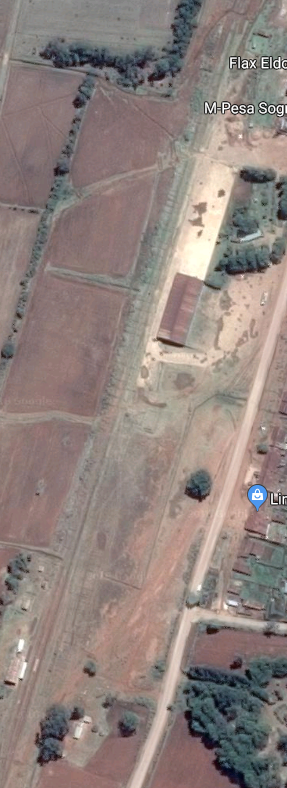 The adjacent satellite image shows Kaptagat Station which is in a loop in the line which belies the direction of travel. The railway is now travelling in a Northwesterly direction and continues from Kaptagat to Cheploske and Plateau.
The adjacent satellite image shows Kaptagat Station which is in a loop in the line which belies the direction of travel. The railway is now travelling in a Northwesterly direction and continues from Kaptagat to Cheploske and Plateau.
The satellite image below shows Plateau Station. The next photograph shows Plateau Station building.

After Plateau, one station remained, Sosian, before trains reached Eldoret. Eldoret is the fifth largest city in Kenya, second only to Kisumu in Western Kenya and the end of this stage of our journey!
The first train picture below is a very early image from colonial times. The map below shows the track layout at the Station.

 Class 60 no. 6008 at Eldoret in 1958.
Class 60 no. 6008 at Eldoret in 1958. Derailment, Eldoret Yard, 1963 (c) Neil Rossenrode. [21]
Derailment, Eldoret Yard, 1963 (c) Neil Rossenrode. [21]

 Derailment in Eldoret Yard in 1964, (c) Neil Rossenrode. [20]
Derailment in Eldoret Yard in 1964, (c) Neil Rossenrode. [20] Class 60 in Eldoret Yard, (c) Peter Davis. [22]
Class 60 in Eldoret Yard, (c) Peter Davis. [22]
References
- “Investing in Uganda’s Mineral Sector” (PDF). http://ugandainvest.com/mining.pdf, accessed on 20th June 2010 – no longer available.
- Wikipedia, Uganda Railway; https://en.wikipedia.org/wiki/Uganda_Railway, accessed 15th May 2018.
- http://www.oldcambrians.com/Train4.html, accessed 24th May 2018.
- https://www.pinterest.co.uk/pin/462463455483881646, accessed 26th May 2018.
- https://www.flickr.com/photos/128839707@N03/17430623451/in/photolist-21LmYUY-fN1DNS-dcEEiS-eEjGME-e6J3D7-hGTeBd-RWxLwQ-aeKxoR-F78ngU-RAuADh-dE1BLJ-RWy87C-syhv5x-iWKDzQ-nBk4b-21SDq8g-S7wXDq-sgJGAW-sy9Psw, accessed on 26th May 2018.
- http://www.mccrow.org.uk/eastafrica/eastafricanrailways/KampalaNairobi.htm, accessed 24th May 2018.
- https://www.flickr.com/photos/youthwith/6775572039/in/photolist-bjJzvz-syhv5x-kb1L9-ijpMZS-5U44mD-bn2NzC-bojoXR-6PHLzC-dxyBy5-ec8xiY-G1SxDj-sgJGAW-6n7s4y-sy9ipf-6riFRd-6riAgq-Xpopdx-4gWSYU-48Eko1-GYcSmb-9RLhA8-F8vFZm-hbYVxX-6SrGXC-mRCD5j-bAnDhS-ab8ZBs-6SrJbQ-cVYkNW-nrEveJ-aeNdcs-dcEEiS-88qc2u-bW6xBx-anC4UM-9phTE9-dhLWA6-9yrcd2-ndUWcA-ow7q5Q-omunYR-5fi4HZ-dhMkh3-9PQA1K-ahCmqV-dhMj1M-9yJt2y-dhMpvT-ejtLxL-dhMpMz, accessed on 26th May 2018.
- https://www.flickr.com/photos/128839707@N03/17429023272/in/photolist-sy9ipf-6riFRd-6riAgq-Xpopdx-4gWSYU-48Eko1-GYcSmb-9RLhA8-F8vFZm-hbYVxX-6SrGXC-bAnDhS-ab8ZBs-6SrJbQ-cVYkNW-nrEveJ-aeNdcs-dcEEiS-88qc2u-bW6xBx-anC4UM-9phTE9-dhLWA6-9yrcd2-ndUWcA-ow7q5Q-omunYR-5fi4HZ-dhMkh3-9PQA1K-ahCmqV-dhMj1M-9yJt2y-dhMpvT-ejtLxL-dhMpMz-7Va4eP-cghReq-dhM7nf-dhMhsp-CVvK3Z-ejtLMG-ej6uDv-cghR8s-chyaZb-9XjosD-dhMtx2-ejo3Di-dhMcg8-aeKpAn, accessed on 26th May 2018.
- https://www.flickr.com/photos/31312468@N00/6816119855/in/photolist-bojoXR-6PHLzC-dxyBy5-ec8xiY-G1SxDj-sgJGAW-mRCD5j-6n7s4y-sy9ipf-6riFRd-6riAgq-Xpopdx-4gWSYU-48Eko1-GYcSmb-9RLhA8-F8vFZm-hbYVxX-6SrGXC-bAnDhS-ab8ZBs-6SrJbQ-cVYkNW-nrEveJ-aeNdcs-dcEEiS-88qc2u-bW6xBx-anC4UM-9phTE9-dhLWA6-9yrcd2-ndUWcA-ow7q5Q-omunYR-5fi4HZ-dhMkh3-9PQA1K-ahCmqV-dhMj1M-9yJt2y-dhMpvT-ejtLxL-dhMpMz-7Va4eP-cghReq-dhM7nf-dhMhsp-CVvK3Z-ejtLMG, accessed on 26th May 2018.
- https://www.theeagora.com, accessed on 21st May 2018.
- https://en.m.wikipedia.org/wiki/Menengai, accessed on 26th May 2018.
- https://en.m.wikipedia.org/wiki/Rongai, accessed on 26th May 2018.
- https://en.m.wikipedia.org/wiki/Maji_Mazuri, accessed on 27th May 2018.
- http://www.friendsofmombasa.com, accessed on 15th May 2018.
- https://www.flickr.com/photos/bvohra/8223072164/in/photolist-dwDoSh, accessed on 26th May 2018.
- https://twitter.com/kresearcher/status/560091036849287168, accessed on 27th May 2018.
- https://www.pinterest.co.uk/pin/90986854943791222/?lp=true, accessed on 27th May 2018.
- http://www.westonlangford.com, accessed 24th May 2018.
- https://www.pinterest.co.uk/pin/559361216210820409, accessed on 27th May 2018.
- https://www.pinterest.co.uk/pin/462463455481301933/?lp=true, accessed on 27th May 2018.
- https://www.pinterest.co.uk/pin/482377810082083293/?lp=true, accessed on 27th May 2018.
- https://www.pinterest.co.uk/pin/559361216210820386/?lp=true, accessed on 27th May 2018.
- Not used
- https://www.flickr.com/photos/128756940@N02/15602334132/in/photostream, accessed on 27th May 2018.































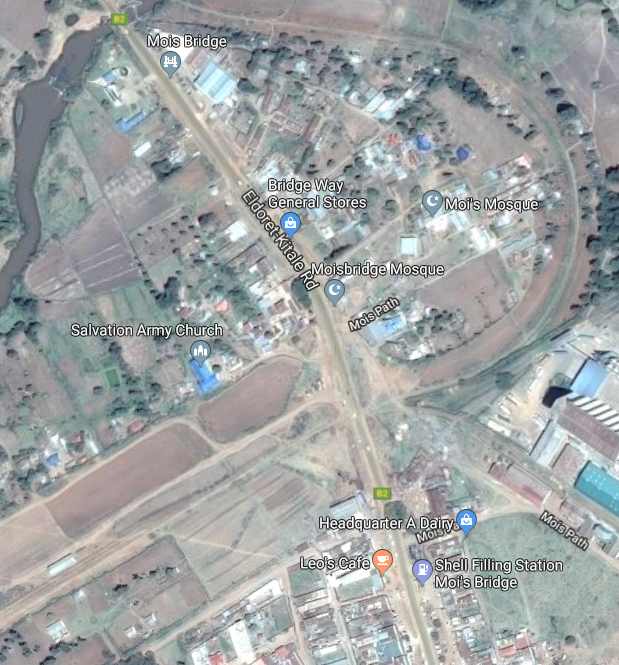





















































 Derailment, Eldoret Yard, 1963 (c) Neil Rossenrode. [21]
Derailment, Eldoret Yard, 1963 (c) Neil Rossenrode. [21]



































































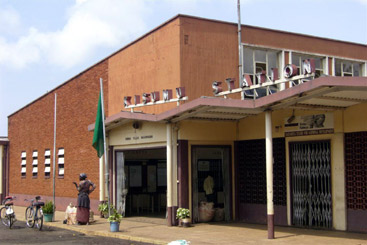










































































































 The project is called ‘Kibera Walls for Peace’. Peace murals were painted by local youth around Kibera. The project approached and worked with Rift Valley Railways to use the commuter trains as a canvas to spread peace messages and togetherness. The railways had been a major target in the previous post-election violence, especially the route through Kibera. In 2007, mobs of young people tore up the train tracks that connect Kenya and Uganda and sold them for scrap metal.
The project is called ‘Kibera Walls for Peace’. Peace murals were painted by local youth around Kibera. The project approached and worked with Rift Valley Railways to use the commuter trains as a canvas to spread peace messages and togetherness. The railways had been a major target in the previous post-election violence, especially the route through Kibera. In 2007, mobs of young people tore up the train tracks that connect Kenya and Uganda and sold them for scrap metal.










 Staff at Nairobi MPD on the occasion of Princess Margaret’s visit in 1956.[14]
Staff at Nairobi MPD on the occasion of Princess Margaret’s visit in 1956.[14]





















 Class 59 Garratt No. 5918 ‘Mt Gelai’ in Steam in 2004.[15]
Class 59 Garratt No. 5918 ‘Mt Gelai’ in Steam in 2004.[15]







